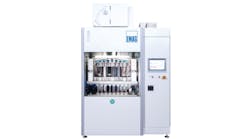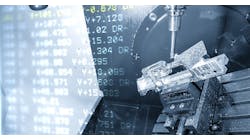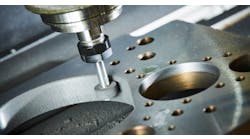Making precise race-car parts in-house keeps John Force teams winning.
Proprietary John Force aluminum blower rotors are gun drilled on a Giddings & Lewis HMC 170 and finished on a Fadal VMC 4020, both running Castrol cutting fluids to enhance precision.
The Force shop machines clutch-plate floaters from steel having a 34-Rc hardness using a standard Fadal 10,000-rpm spindle.
A Fadal VMC mills the I.D.s and O.D.s of steel clutch plates.
A 120-pocket cassette-style toolchanger (expandable to 250) stores tooling for machining prototype and production 7,000-hp aluminum cylinder heads.
Copper and Brass supplies 6013 aluminum for these cylinder heads, which along with Fadal and G&L, is a division of Thyssen-Krupp. 6013 is a special aluminum that is stronger, easier to machine and lighter and produces a better finish than other aluminum alloys.
By bringing work in-house, John Force Racing Inc. is no longer busting its hump to beat the competition. Besides keeping spindles busy, machining in-house lets the team build and retain its knowledge base and keep a tight lid on creative ideas.
When crew chief John Medlen started working for Force, most team shops bought offtheshelf parts and assembled their cars and engines. The innovators at that time were the retailers that manufactured the parts and sold them to all aspects of the racing industry. Eventually, Medlen's shop personnel developed original ideas that improved car performance or gave a broader range of adjustability. The shop then would have a particular manufacturer produce the component.
But once the component proved successful, the manufacturer would sell it to Force's competitors. "We would blast ahead in performance. Then shortly, our competitors would jump right next to us. We were just spinning our wheels, spending a lot of energy, effort and money developing components, while our competitor merely sat at the table and waited," explains Medlen.
Tired of spinning its wheels, the shop decided to make the components in-house, and bought its first machine tool from Fadal Machining Centers of Chatsworth, Calif., later approaching them for a sponsorship. Eventually additional machines to produce more components made their way into the shop, which currently boasts an HMC 170 Giddings & Lewis (G&L) horizontal machining center and model 6535, 6030, 4020, 4525, and 3020 Fadal VMCs. The machines cut a lot of RK 60 plate and AZ31B magnesium parts from Force's own castings.
Besides magnesium, the shop works with aluminum alloys, titanium and steel. It manufactures its own cylinder heads, clutch parts and blower components and is launching a block-and-cylinder-head program for Ford.
"When you design and make a part in-house and then take it out and try it, the part either fails or succeeds," explains Medlen. "The by-product is that we keep the learning curve and we retain the knowledge, whether or not the attempt was successful. Thus, over time, we improve our manufacturing ability and, better yet, stop funding our competitor's education."
For instance, the shop manufactures rotors for blowers out of material that others said would not work because there was too much stress in it. But with Force's process, the part is absolutely stress-free and stays perfectly flat and straight, just as originally machined. "That process came from our previous knowledge on keeping stress out of cylinder heads," says Medlen.
Controlling the proprietary nature of ideas is a big performance advantage for Force — add to that an increased accuracy of machined components. Before it started machining in-house, the fit, tolerance and attention to detail of components wasn't always acceptable. The biggest problem was lack of control over this. However, the company now easily fixes machined components that, for whatever reason, aren't quite right.
The shop also has more control over part design as it relates to part lightness, durability and strength, and it puts a lot of effort into selecting materials with specific tensile and elongation qualities.
For instance, when purchasing 7075 aluminum, which has a range of 48,000 to 78,000 tensile, the shop specifies the higher-rated plate, and every piece of material is certified.
"What we've learned in manufacturing race-car parts could enhance and improve the private sector," says Medlen. "That sector should put a greater emphasis on taking the process from idea to finished part than it currently does. I think the greatest lesson for the private sector is a method we call 'process format'." This process starts with concepts, and proceeds to creating models, fixturing and tooling the models, and then machining them — performing these steps exactly the same every time.
Such process familiarity, in turn, slashes the learning curve for pioneering new applications that may or may not be advantageous. Also, when the shop changes from one part to another, it doesn't have to re-educate operators. "We aren't losing ground from confusion. Adhering to a particular process is quicker, faster, and has less error," explains Medlen.
The machine knows
Medlen says the race cars are like piranhas, constantly eating more parts than the shop can make. For this reason, the shop motto is, "Focus on keeping the spindles turning." Helping it do this are the Fadal VMCs, two of which work 24 hr/day, five and six days a week, and the G&L horizontal.
He says the G&L's capabilities are so exceptional they actually boost operator learning curves. "We are probably using only one tenth of its capabilities. Its control and accuracy teach us things beyond the stroke of our imagination. We hold closer tolerances, do more axis positioning, and complete more part processes than with other horizontals," he points out.
The shop originally purchased the G&L to rough-out cylinder heads, which it currently pumps out at 200 a year for the team's three Funny Cars. The machine also roughs blower rotors, bores and machines blower-cases, roughs and semifinishes cylinder heads, and machines other components such as injector parts.
"One of machine's strong features," reports Medlen, "is the accuracy and repeatability of the pallets and the B-axis when it rotates. "We bore a blower case that is 20 3 19-inches long, and we have to hold that bore within 0.001 inch for the entire length. A 24-inch-long boring bar bores cases with special contours and does so eight times. Thus the machine has to pick up right where it left off without deviating
because the cuts are 0.001-inch envelopes for relieving material, necessary to account for the expansion and contraction of the case during operation." Accuracy is also critical because the shop makes components for several cars. In trying to gather data from all the cars collectively, if the parts are different on each car, then the data retrieved is meaningless because it deals with three individual entities, rather than a commonality.
Other advantages of the G&L are positioning and its work envelope. "Many parts have deep cavities. The part position lets us easily evacuate the chips, and this, in turn, generates high speeds and feeds. And the horizontal's rigidity is a big factor when pushing speeds and feeds. We have yet to push the G&L, which has a 60-hp motor, to its limits," he remarks.
And with the feedrates on the verticals being 400 and 500 ipm Medlen says the hurdle is now tooling — it's no longer the machines. At these rates, the shop can't easily use a 0.75-inch or 1-inch end mill to go 0.250 or 0.500-inches deep. "The machines take the material out of the part as fast as you can get the chip away from the tool," says Medlen.
JOHN FORCE, RACE-CAR TEAMS
John Force won 13 NHRA Funny Car championships and is the owner of John Force Racing. His machine shop includes Fadal VMCs and Giddings & Lewis HMCs so high end, they help teach him and shop personnel cutting-edge racing technology.
Two machine shops support the several Force racing-car teams. The Indy shop is in Indianapolis, and the original shop is in Yorba Linda, Calif. Which shop Force uses depends on whether it is racing on the East or the West Coast.
John Force Racing Inc. has several cars, each of which competes in the National Hot Rod Association (NHRA). The cars are the Castrol Hot Wheels, an A-Fuel Dragster, and the AAA — Auto Club of Southern California, the Castrol Syntec, and the Castrol GTX Start-Up, all Ford Mustang Funny Cars. Dragsters feature engines that are behind the drivers, are long (wheel base is 270-300 in.) and openwheeled. On the other hand, Funny Cars are shorter (wheel base is 125 in.) and are completely covered with carbonfiber bodies.
JOHN FORCE, RACE-CAR DRIVER
A Fadal V300 rotary table on the VMC 4020 allows simultaneous four-axis contouring on complex aluminum blowers.
John Force, owner of Force Racing Inc., is a Funny Car racing champion. In 2004, he got a 13th career NHRA POWERade Funny Car world championship. That same year, he finished in the top three POWERade point standings. He also established the national time (4.665 sec) and speed (333.58 mph) records at the Chicago 2 event. In addition, Force and his daughter, Ashley, who is a Top Alcohol Dragster driver, won Pomona 2, making them the first father-daughter duo to win at a national event.
For more information on automoive racing...visit americanmachinist.com





